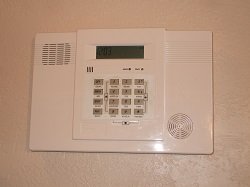- Home
- Compare Systems
- Cheap Systems
- Free Quotes
- DIY Systems
- Hardwired Systems
- Wireless Systems
- Smoke Detectors
- Medical Alarms
- Alarm Monitoring
- Cameras & Video
- Ademco
- ADT Security
- Brinks Security
- Broadview
- DSC Security
- FBI Alarms
- GE Security
- Honeywell
- Link Interactive
- Monitronics
- Moose
- Napco
- Protection 1
- Radionics
- Simplisafe
- Alarm Manuals
- Alarm System Parts
- Alarm Tools
- Troubleshooting
- FAQ
- Glossary
- Sitemap
- About Me
- Contact Me
Home Wireless Security Systems Layout
Despite the name, most home wireless security systems do require a few wires. These connect the main panel to power, a wired keypad, and a telephone line. Usually, a little planning will allow the unit to be located a short distance from these things. The few wires needed can be fished vertically through the wall, or stapled to trim or baseboards.
Here are some things to consider when deciding where to place each piece of equipment. Whether you’re thinking about a DIY home alarm system or shopping home alarm companies, this will help you get the best wireless home security system.
Home Wireless Security Systems Main Panel
Home wireless alarm system panels are often placed in the laundry room, near the entry/exit door to the garage. Power can often be found along one of the interior walls, and a phone jack is sometimes wired in the garage. If there is attic access, a phone line can easily be run. This could go to the nearest jack, or directly to the service drop on the outside wall of the garage.
Telephone Connection
Non-monitored home wireless security systems don’t really need a telephone connection, unless you’re getting a system that allows remote access features. It’s still a good idea, since then you can easily have the system monitored in the future.
Powering the Wireless Alarm System
Power is supplied by a small plug-in transformer. This runs the panel, and charges its back-up battery. The outlet used must be un-switched, which is usually the case in laundry areas. If the transformer were plugged into a switched outlet, and someone turned off the switch, the alarm would drain its battery in a few hours.
Wireless All-in-One Systems
Systems like the Ademco Lynx combine the keypad, dialer, receiver, and other major components in a single unit. These types of systems still need a nearby 110-volt receptacle, to plug in the transformer. They also need a telephone connection for monitoring to work.
This minimal wiring makes installation
simpler than larger systems, and is a perfect fit for a smaller house or apartment.
Find out more on the best wireless home alarm for apartments and rentals.

Alarm Keypad Location
Unlike the "all-in-one" types, other home wireless security systems use a keypad separate from the main panel. The keypad is needed for programming, and some alarm systems combine it with a built-in receiver. Locating the keypad directly below the panel, next to the garage door, is the easiest, since a short wire can be fished down the wall to connect the two.
Keypad Placement - Inside or Outside?
The keypad can be placed inside or outside the door, your choice. Opinions differ on which of the two is “better”, even among alarm professionals. I’ll tell you the arguments for each, and you can decide!
Inside Keypad Advantages
Arming Option: A keypad inside the house can be used to arm and disarm the system,
without opening the door. This is good if you only have one keypad and
you intend to arm the system at while you’re home.
Audible Alerts: Inside keypads can be heard through the rest of the house much
easier than outside units. This is mainly helpful only if you plan on
having the “chime” feature on when you’re at home.
Tamper Prevention: Many people want the keypad inside to prevent tampering and
disabling the alarm. While modern systems can’t be disarmed without
entering a valid code, a keypad/receiver combination unit could be
damaged so as not to receive alarm signals from transmitters.
Security: Another worry with an outside keypad is that someone can see if the alarm is armed or not.
Both of the last two issues are more of a concern if you have an open carport, rather than an enclosed garage. Garages are fairly secure, considering how much easier it is to break into a window.
Outside Keypad Advantages
Early Warning: An outside keypad can alert you to an
alarm condition before you even get out of your car. You can then back
out of the garage, go to a neighbor’s house, call your alarm company,
etc. This is probably the biggest single advantage of having a keypad in
the garage, and many people base their decision on this.
Arming Option: Another minor plus to the outside location is extra arming options. When leaving the home, most systems allow you to arm the system without the usual delay on the garage door. This means the alarm will sound instantly on opening the door, leaving an intruder no time to try to defeat the system. It’s true that this is more secure than having a delay, but many people never use the feature anyway.
The Bottom Line:
Think about how you and your family will use the alarm system, along with the points above, and pick the keypad location you’re most comfortable with.
The Garage Interior Door
There is another benefit of placing wireless burglar alarm systems
next to the garage interior door: This allows the door to be hardwired.
Many wireless panels also have a zone or two available on the circuit
board for hardwired points. How does this help us?
Being the main entry/exit door in most single-family homes, the garage door gets the most use of any opening in the house. If a wireless transmitter is used to secure it, it will transmit every time the door is opened or closed. (Many units are designed to send several rounds of signals for each opening or closing). This will wear its battery out much faster than the other transmitters in the system.
By hardwiring this door, there is no transmitter needed, and no
battery to change. As a bonus, you’ll save a little money, since
hardwired contacts are cheaper than wireless transmitters.
Even though home wireless security systems aren't totally wireless, plan ahead of time for the few wires that are required will make your whole installation go easier.
Looking for a driveway bell? Check out this article on a Wireless Driveway Alert System from Bunker Hill Security.
Adding a wireless keyfob remote control makes an alarm system easier to use. Learn more about Wireless Burglar Alarm Systems Made Even Better!
If you haven't done so already, get a few Free Home Security Systems Quotes from companies in your area.
This will give you a good idea of what it would cost to have a system installed, as well as how much you could save by doing it yourself.
Return to Home-Security-Systems-Answers from Home Wireless Security Systems
Return to Wireless Home Alarm Systems from Home Wireless Security Systems
Note: Feel free to print any of the articles on this site for personal, non-commercial use. Just look for this button:
If you found this website especially helpful, you might want to consider making a small donation. Since 2011, AzAlarmGuy has been providing free help and advice on home security systems to all of those in need.
Your gift, in any amount, will help me keep this website a free resource for anyone needing help with alarm system issues or questions.
Disclosure
I receive affiliate commissions from some of the companies and products I discuss. These commissions don't change the price that you pay.
Rest assured that this compensation does not influence my recommendations. I only endorse products and services that I truly believe to be an honest value for you, as a visitor to my site.
For more details, see my full disclaimer.





